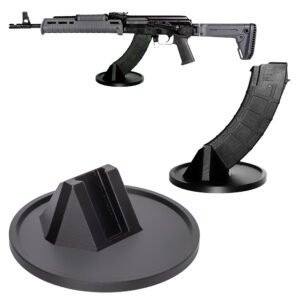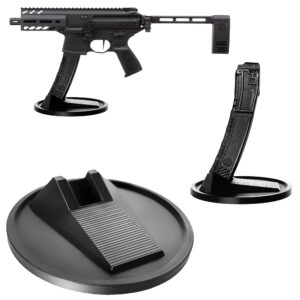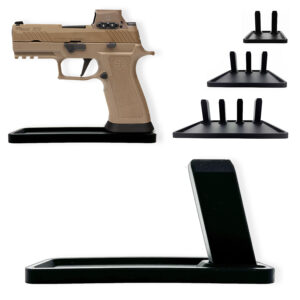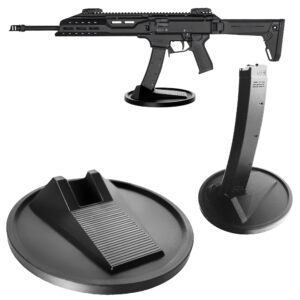
Categories:
Perhaps no gun in history has received the fame, praise, and criticism of the AR-15 rifle. In the United States, the political advances of gun rights have easily made the AR-15 the poster child for both sides of the debate. No other gun is as beloved by gun rights supporters as the AR-15, as the rifle represents the perfect example of the Second Amendment.
On the Other side, gun control supporters see it as a weapon of mass destruction designed to eliminate lives due to the nature of the gun. They bring up its ability to rapid-fire and expand magazine capacities. Even though this rifle (and many others like it) is used in less than 1% of total deaths in the United States, there is no denying that this gun is in the spotlight for both sides of the debate.
The AR 15 gets its name from the Armalite Rifle Model 15. Contrary to popular belief as well as by misinformed gun control advocates, “AR” does not stand for “assault rifle.” It stands for “Armalite Rifle.” In 1956, designer Eugene Stoner presented his Armalite Model 10 design to the United States military as a possible replacement for the famous M1 Garand. Eugene Stoner was well known for being quite the designer and engineer, but he will forever be known for his designs that led to the infamous AR-15.
At the time, the United States Army searched for a new service rifle that could be chambered in 7.62 NATO, which had been adopted only two years earlier. While Stoner’s AR 10 design was not eventually adopted, it did not go unnoticed and was considered by some other nations, such as Spain, and some commercial variants were ultimately made.
Instead of the AR 10 design, the United States military went with the Springfield M14. At the time, they felt this rifle was superior for many reasons, such as reliability, a proven track record in design, and build quality. Unfortunately, this gun was heavy, and many argued that more modern firefight engagements were being fought much closer than the 600 or more yards the 7.62 NATO was initially intended for.
Around that same time, gun manufacturer Remington Arms was developing a new, small-diameter cartridge with increased velocity, specifically for use as a medium-range rifle caliber. This .223 cartridge was used as the basis of Stoner’s designed scaled-down AR 10 that he was experimenting with. This later became named the Armalite Rifle 15, or AR 15, as we commonly know it today.
By 1959, the Armalite Company had extreme financial problems and could not manufacture or experiment more with their new rifle. To combat this, they ultimately sold off the design of the AR-15 to another gun manufacturer, Colt. Colt would later become one of the biggest producers of the AR 15 platform for a significant length of time.
The Colt AR-15 soon became military use in the early 1960s, offering United States Air Force and Special Forces shooters select-fire options. When the United States became involved with Vietnam in 1963, it soon became apparent that Springfield Armory could not keep up with the production of the standard M14 battle rifles. This was the perfect opportunity for the AR 15 platform.
Many people proposed expanding the production of the M14 to some other companies, but the idea was eventually scrapped because of the high cost of the M14 to manufacture. It was a great rifle, but it cost a lot to make, its cartridge required more resources, and it was considered mainly overkill for 300 yards or fewer fights.
The Secretary of Defense at the time, Robert McNamara, decided to put the select-fire AR 15, or M16, into total production for the war. This new rifle was much lighter and easier to carry, the ammo was much less expensive, and it was easily controlled while firing on full-automatic. All these reasons gave way to giving the American troops M16s, and Colt was awarded the contract to make it happen.
Once the new M16 was issued to combat troops in Vietnam, it was considered new and untested. War is not the ideal place to test-run a new gun, and this problem became apparent quickly. The humid jungle environment, coupled with the tolerances in the weapon, was the perfect recipe for malfunctions in the platform.
Using a new weapon in the middle of a war will have its fair share of problems, and there were even reports of dead soldiers being found after a conflict with their rifles completely dissembled to get them working again before they were tragically killed.
When compared to other guns that had been previously used on the battlefield, such as the M1 Garand, the M16 not only looked significantly different, but it functioned differently as well. While the potential was to be a great battle rifle, this was often overlooked because of all its issues.
Luckily, many complaints were heard, and a few quick but smart design changes were made. Training programs were started to teach soldiers how to feed and care for their weapons properly, new models were installed with a forward assist feature, and ammunition was put back to all powder, all of which helped combat the reliability issues noted. These training programs taught soldiers how to properly take down, build their guns, and keep in the fight instead of being at the mercy of a jammed rifle.
This quick overhaul of the M16 made the entire platform a much more reliable and functional weapon out on the battlefield. Because of its weight and controllability, the average American soldier could use this gun much more effectively and run a negligible risk of malfunctions, although they still did happen.
Over the lifetime of its service, minor changes were made to help tolerances and reliability issues. No matter what make or model, any gun will jam and malfunction if not cleaned and cared for properly, but the M16 quickly became known for being notoriously willing to stop at a moment’s notice. With these minor improvements, many soldiers came home from the war confident and happy with just how lightweight the gun was and how effective it was on the battlefield.
The AR 15 after the War
After the Vietnam War, the M16 was officially made the United States military service rifle. While it had its hiccups, the low cost and high magazine capacity helped lead it to where it was. Colt still had a hold on the design and most of the production, and when the war was over, they continued making the civilian, non-select fire AR 15 for the growing civilian market.
At first, the AR-15 was only somewhat popular among civilians. In fact, during the 1960s and 1970s, there needed to be more AR-15 manufacturing or popularity, with only small numbers of rifles being made. Many gun shooters did not see a need or a want for this new gun, and overall demand was deficient. It wasn’t until the 1990s when the AR-15 hit the big spotlight among Americans and worldwide, although maybe not in a good way.
The 1994 Federal Assault Weapons Ban did little to save any lives, but it did help bring light and attention to the AR-15. This ban resulted from an effort to curb gun violence, although it did have a sunset clause made for 2004. While the AR15 was still legal during this ban, it had to be severely modified, and special restrictions were implemented.
While technically, the Federal Assault Weapons Ban restricted certain guns and gun accessories, it almost helped the AR-15 rise to power. During this period, the manufacturing of the AR 15 continued, and because the ban had a sunset clause, it was set to end after the ten years were up. Studies have long shown that the ban had little effect on doing anything, significantly curbing criminal activity, gun violence, and overall lethality of gun crimes. There were several attempts to renew the ban when it ended, but none were successful.
With the Ban’s end in 2004, gun sales started to increase. Many gun owners were fueled to buy these guns either for the novelty or in fear that another ban may soon be enacted. This fear was fueled even further with every tragic event, such as mass shootings or even something as simple as words from anti-gun politicians. While this helped the AR-15 gain popularity, it wasn’t the only reason this gun quickly became popular.
Another reason the AR 15 quickly rose to power and became so popular was its modularity. Once the craze started taking effect, almost every major guns manufacturer produced their variant rifle. Also, factor in the hundreds of other small manufacturers that started making their receivers, parts, and accessories, and the gun quickly became one of the most popular guns to own, build, and accessorize. There are even 80% lower receivers that can be legally bought and used to allow a person to finish making their gun, and all that is needed is a few simple tools that can be purchased anywhere.
Modularity and Many AR 15 Variations
As mentioned, the AR-15 is easily one of the most modular gun platforms today. Parts and pieces can easily be swapped out and replaced, there are plenty of options at all different price points, and it can be effectively shot by just about anyone. A distinctive two-part receiver is used in military and civilian models, allowing for easy takedown and cleaning. This did not stop efforts to upgrade or replace the gun, however.
The AR 15/M16 platform has seen a few attempts for upgrades and replacements for military and police purposes. Many calibers, such as the 6.8mm SPC and the 300 Blackout, have been created and tested specifically for the platform.
Speaking of different calibers, the AR 15 can be chambered in many ways. Sometimes, the only thing needed is a simple swap of the upper receiver and bingo! You now have a new caliber weapon. While the staple 223/556 is super popular, you can find or chamber an AR 15 in calibers such as 22LR, 17 HMR, 204 Ruger, 224 Valkyrie, 243, pistol cartridges such as 9mm, 40 S&W, 45 ACP, as well as many other cartridges out on the market today. The bigger brother AR 10 can handle longer cartridges such as the 22-250, 6.5 Creedmoor, 257 Roberts, 7MM, 308, 300 Winchester, and many others.
Because of the versatility of the calibers, the AR 15 and AR 10 have become increasingly popular among shooters, long-range precision sharpshooters, and hunters. Getting a semi-automatic rifle in your caliber of choice for the intended purpose you want to pursue has made it an all-around favorite.
The AR platform can shoot in different calibers and be outfitted in almost any shape or configuration you can imagine. Thanks to aftermarket parts, the other barrel lengths, stocks, rails, handguards, grips, scopes, optics, lasers, lights, triggers, etc., give so many different options for the AR 15 that it is almost impossible to find two identical guns.
There are many options today to customize an AR 15 and set it up exactly how one prefers. Because of the universality, availability, and domestic manufacturing of the gun and its components, prices have recently gotten lower and lower, making it easier to own an AR-15.
AR 15 in the News and Media
Unfortunately for the AR-15, despite its massive success among civilian shooters, it rarely sees favorable media mentions. Especially among tragedies, the AR-15 and other semi-automatic sporting guns are usually portrayed unfavorably.
Take, for example, January 17, 1989. Patrick Purdy, a madman, walked into a schoolyard in Stockton, California, and opened fire with his AK47. He killed five children and wounded thirty-two others before eventually dying. Even though it was not even an AR 15 involved in this incident, Colt decided to suspend sales of its AR 15.
Every time a shooting occurs, the AR-15 is posted front and center on the page of every newspaper as if it was guilty of killing innocent people instead of the lunatic that used it. In shootings such as Orlando, Las Vegas, and Sandy Hook, the AR-15 took the brunt of the blame every time there were calls for more gun control legislation.
While there is no debate that the AR-15 is showing up in more and more mass shooting tragedies, it has mainly gotten a bad rap from the media and anti-gun haters. When talking about AR-15s and their part in shootings, a gun owner from Illinois gave his input on why many mass shooters choose the AR-15. “It’s just a perception thing,” he said, “There are rifles that are much more dangerous and powerful that are not being used.” Many mass shooters are believed to choose the AR-15 because they are so popular, and usually do not know much about guns.
While these incidents must stop, putting all the blame on the AR-15 does not make sense. Most of America’s shootings (totaling around 40,000 yearly) involve handguns, not rifles. But the media often quickly blame the “scary” black rifle, the AR-15, even if the gun wasn’t used in the incident.
For example, after a shooting at Santa Fe High in Texas killed ten people, the story made its rounds on social media. It portrayed several inaccurate statements, including the city of Santa Fe and the use of an AR-15. The only problem was this: the madman was accused of using a shotgun and a small revolver with no AR-15s in sight. This is not the first time inaccurate statements were made in the media about the AR-15, and it surely will not be the last.
The media may never be kind to the AR 15. Gun control supporters are unfamiliar with guns and will most likely never be, but that will not stop attempts to shed a bad light on the platform and its uses. The best thing we can do as gun owners is to educate and show the real-life benefits of owning and using a rifle such as the AR-15 and take the right actions against threats, not trying to disarm law-abiding gun owners.
As you can see, there’s no way of denying that the AR-15 holds and will continue to hold a prominent place in guns history. Whether people see it as the best rifle ever made or as a tool of destruction, it is easily recognizable and famous worldwide.
While the AR-15 is still up for consideration for upgrades or replacement within the confines of the military and police forces, for now, it remains the go-to platform and is in active use. Even though gun bans and legislation are still a genuine threat in today’s political climate, the 18 million AR-15s worldwide ensure they are not going away anytime soon.
With some proper care and maintenance, an AR-15 made today could still be an effective weapon 100 years from now. No amount of gun laws or bans will change what is already out there or get the genie back into the bottle. With so many AR 15s in the hands of people, it would be nearly impossible to get them all back.
With more and more companies and manufacturers jumping into the civilian AR 15 market, it is safe to say, at least for now, that the AR 15 is here to stay. Whether you use your rifle as a tool, self-protection, a precision instrument to hunt animals, or as a statement of freedom, the AR-15 has rooted itself deeply into American culture.
While it may have even gotten off to a rocky start, the AR-15 still worked its way into the guns industry and completely dominated it like it does today, being one of the most popular guns and proving to be “America’s Rifle.”








Colt
Colt M4 Carbine
Colt LE6920
Colt AR-15 A4
Daniel Defense
DDM4 V7
DDM4 V9
DDM4 V11
DDM4 ISR (Integrally Suppressed Rifle)
Smith & Wesson (S&W)
M&P15 Sport II
M&P15 Tactical
M&P15T
Bravo Company Manufacturing (BCM)
BCM Recce-16
BCM Recce-14
BCM MCMR Series
Aero Precision
M4E1 Series
AC-15
AR15 Pistol (Various Configurations)
Ruger
Ruger AR-556
Ruger SR-556
Ruger AR-556 MPR (Multi-Purpose Rifle)
Springfield Armory
Saint Victor
Saint Edge
Saint AR-15
PSA (Palmetto State Armory)
PSA PA-15
PSA AR-V
PSA Jakl (AR Pistol)
FN America
FN 15 Tactical Carbine
FN 15 Patrol
FN 15 DMR
Wilson Combat
Recon Tactical
Super Sniper
Protector Carbine
SIG Sauer
SIG M400 Tread
SIG M400 Elite
SIG M400 SDI
LWRC International
IC DI (Direct Impingement)
IC SPR
IC A5
Bushmaster Guns
XM-15 QRC
Bushmaster MOE
XM-15 Patrolman
Rock River Arms
LAR-15 Entry Tactical
LAR-15 Predator
LAR-15 Elite Comp
Stag Arms
Stag 15 Tactical
Stag 15L (Left-Handed Models)
Stag 15 Valkyrie
Noveske Rifleworks
Noveske Gen 4 N4
Noveske Space Invader (AR Pistol)
Noveske Recon
Anderson Manufacturing
AM-15 Optic Ready
AM-15 M4 Carbine
AM-15 Precision Rifle
Adams Arms
AA-15 Piston Rifle
P2 AARS (Adams Arms Rifle Series)
Black Rain Ordnance
SPEC15 Series
BRO Predator
Fallout 15
Diamondback Guns
DB15 Series
DB15CCMLB
DB15EB
Del-Ton Inc.
DTI-15
Del-Ton Echo 316H
Sierra 316M
Windham Weaponry
Windham SRC
Windham VEX-SS
Windham RMCS-4 (Caliber Conversion System)
Christensen Arms
CA-15 G2
CA-15 Recon
CA-15 Titanium Edition
Patriot Ordnance Factory (POF-USA)
Renegade Plus
P415 Edge
Revolution DI
LaRue Tactical
PredatAR
OBR (Optimized Battle Rifle)
LaRue Stealth 2.0
Battle Arms Development
Workhorse Patrol Carbine
BAD556-LW (Lightweight)
Authority Elite Rifle
Faxon Guns
Ascent AR-15
FX-19 (AR Pistol)
Streamline Ultralight Series
KE Arms
KE-15 SLT (Super Lightweight Tactical)
KE-15 Scout Carbine
Primary Weapons Systems (PWS)
MK1 MOD 2-M
MK116 PRO
MK107 (Piston AR Pistol)
ZEV Technologies
ZEV Core Elite Rifle
ZEV AR15 Billet Rifles
Franklin Armory
BFSIII AR-C1
Militia Model
F17-L (Chambered in .17 WSM)
Seekins Precision
SP15 DMR
NX15 Skeletonized Rifle
Havak Bravo
Aero Precision (Additional Models)
EPC-9 (Pistol Caliber ARs)
VG6 AR Rifles
Barrett Guns
REC7 DI
REC7 Gen II
CMMG
MK4 RCE
Resolute 300
Banshee (AR Pistol)
DPMS Panther Arms
Panther Oracle
Panther LR-308
H&K (Heckler & Koch)
HK MR556A1
HK416 (Military Variant)
Rock Island Armory (Armscor)
VR-80 Tactical AR (Shotgun AR Platform)
Troy Industries
Troy SPC-A3
Troy PAR (Pump Action AR)
Wilson Tactical
Tactical Recon AR
Protector Series
F1 Guns
FDR-15 Skeletonized Rifle
BDRx-15 Series
Juggernaut Tactical
JT-15
JT-10 Precision Rifle
AeroSurplus
Surplus AR-15 Rifles (Budget Models)
Thunder Tactical
AR-15 Basic Carbine
Tactical Builder Sets
Radical Guns
RF-15
Forged AR-Series
Dark Storm Industries
DS-15 Featureless Rifles
DS-10 Typhoon
DRD Tactical
Paratus
Aptus AR Rifles
Bear Creek Arsenal
BCA-15
AR Complete Upper Builds
Aero Survival Rifles (ASI)
ASR Tactical Series
Tactical Edge
WARFIGHTER Series
AR-15 Lightweight Rifles
Lone Star Armory
TX15 DMR
TX15 Carbine
HERA Arms
HERA H7
HERA AR-15 Lower Builds
IWI (Israeli Weapon Industries)
Zion-15
DRD Tactical
Tactical Modular Rifles
Quick-Takedown Rifles
V Seven Weapons
1776 Rifle
Hyperlite Rifle
Core Rifle Systems
Core15 Tac III
Core15 Patrol Rifle
Armalite (Original AR-15 Creator)
M15 Tactical
M15 A4 Carbine
DEF15 (Defensive Sporting Rifle Series)
PSA (Palmetto State Armory Additional Models)
PSAK-47 Hybrid (AR-AK Style Hybrid)
PSA Dagger (Pistol Caliber Configurations)
Odin Works
OTR-15
Odin Recon Rifle
Maxim Defense
MDX-508 PDX (Compact AR Pistol)
MDX-510 Rifle